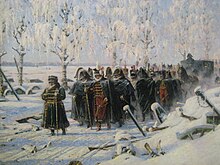Battle of Kaidanowo
| Battle of Kaidanowo | |||||||
|---|---|---|---|---|---|---|---|
| Part of the French invasion of Russia | |||||||
 Napoleon's retreat by Vasily Vereshchagin | |||||||
| |||||||
| Belligerents | |||||||
|
|
| ||||||
| Commanders and leaders | |||||||
|
|
| ||||||
| Strength | |||||||
| 3,800[1]–4,000[2] | 1,300[1]–2,000[2] | ||||||
| Casualties and losses | |||||||
| Unknown | 1,000[1]–2,000[2] | ||||||
The Battle of Kaidanowo was fought on Sunday, 15 November 1812, near the village of Kaidanowo, part of the Russian Empire at the time.[3] A Lithuanian,[4] Württembergian, and French force under General Franciszek Ksawery Kossecki of 1,300-2,000 was defeated by seasoned Russian forces led by General Charles de Lambert of about 3,800-4,000.[3][2][1]
Background
On one side was General Kossecki's division, which had been mauled two days previously at Nowo Schwerschen, reinforced after the battle with Württembergian infantry and French cavalry units.[3] On the other side was cavalry from the Army of the Danube.[3]
Order of Battle
According to Pugačiauskas, the regiments under Kossecki were:[5]
- incompletely formed 22nd Lithuanian Infantry Regiment (1,500)
- 18th Lithuanian Uhlan Regiment (940)
- Kossakowski's Chasseurs à pied Regiment (two battalions, total 634)
Battle
Lambert mounted a pursuit, catching them at Kaidanowo, where he destroyed most of the detachment.
The Russian cavalry charge proved devastating, as the unseasoned 22nd Lithuanian Infantry Regiment did not withstand it and retreated.[4] The regiment's commander, Stanisław Czapski, tried to halt the retreat and even shot insubordinate soldiers, but his actions were unable to rectify the situation.[4] All three Lithuanian regiments suffered losses.[5]
Kossecki and about 100 of his cavalry escaped back to Minsk.[6]
Aftermath
Of the 22nd Lithuanian Infantry Regiment, a mere 30 officers and 53 soldiers remained.[4] Stanisław Czapski was awarded the Legion of Honour by Napoleon due to his effort in this battle.[7]
The 18th Lithuanian Uhlan Regiment survived this battle, which was its first, relatively unscathed, as it managed to evade Russian capture and retreated towards Berezina.[8]
Bronikowski and about 1,000 men evacuated Minsk and, including about 500 men of the 7th Württembergian Infantry Regiment, marched to Barysaw. A number of civilians of the administration together with many soldiers escaped to Vilnius, where they caused a panic because the inhabitants thought that the Russians were following them.[6]
See also
References
- ^ a b c d clash-of-steel 2021.
- ^ a b c d Bodart 1908, p. 443.
- ^ a b c d Smith 2004, p. 147.
- ^ a b c d Pugačiauskas 2019, p. 33.
- ^ a b Pugačiauskas 2007, p. 108.
- ^ a b Riehn 1990, pp. 367–368.
- ^ Pugačiauskas 2019, p. 37.
- ^ Pugačiauskas 2019, p. 16.
Sources
- Bodart, Gaston (1908). Militär-historisches Kriegs-Lexikon (1618-1905) (in German). Retrieved 10 April 2021.
- clash-of-steel (2021). "Battle Name : Kaidanowo". Retrieved 10 April 2021.
- Pugačiauskas, Virgilijus (2007). "Lietuvos nuostoliai 1812 m. kare". Karo Archyvas (in Lithuanian). 22. Vilnius: General Jonas Žemaitis Military Academy of Lithuania: 89–110. doi:10.47459/ka.2007.22.3. ISSN 1392-6489. S2CID 240264768.
- Pugačiauskas, Virgilijus (2019). XIX a. Lietuvos karinių dalinių istorija (in Lithuanian). Vilnius: General Jonas Žemaitis Military Academy of Lithuania. ISBN 978-609-8074-97-0.
- Riehn, Richard K. (1990). 1812 : Napoleon's Russian campaign. McGraw-Hill. ISBN 9780070527317. Retrieved 10 April 2021.
- Smith, Digby (2004). Napoleon against Russia: a concise history of 1812. Great Britain: Pen and Sword Military. ISBN 9781783409587.
External links
 Media related to Battle of Kaidanowo at Wikimedia Commons
Media related to Battle of Kaidanowo at Wikimedia Commons